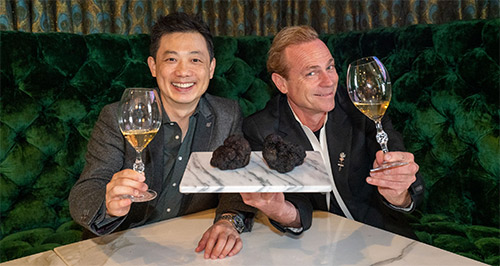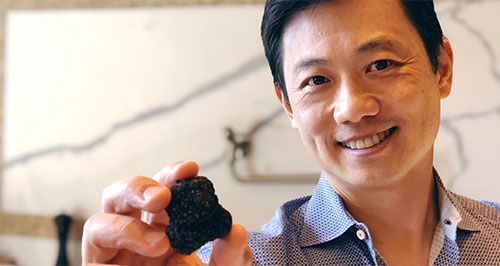Nob Hill Gazette (July)
THEN (2008, Munich): A man walks into a restaurant: a young Stanford graduate (Bachelor of Science degree in engineering; Master of Science degree in biology); an Italian bistro. He (let’s call him the techie) orders butter-tossed tagliatelli with black truffles shaved on top. He never had truffles before; it was a life- changing experience. Back home stateside, he sees that truffles are all imported and extremely expensive. And he wonders,“Can I grow truffles?” He does in-depth scientific research on the subject. His research leads to only one guy with credible scientific knowledge on growing truffles. But the scientist lives in the United Kingdom. A flight to London and a long lunch meeting turn into a grand partnership to cultivate black truffles that equal France’s famous black truffles. Voilà! The American Truffle Company (ATC) takes root.
NOW: The two young founders—our techie Robert Chang, who became ATC’s managing director, and the scientist, Dr. Paul Thomas, who continues to live in the United Kingdom and remains the world’s leading authority on truffle cultivation technology—have since built a global network for growing truffles, a.k.a.“black diamonds,” in 25 countries—and now, right here in the Napa Valley.
Australia began its first black truffle harvest last summer. According to Ken (King of Truffles) Frank, of Napa’s Michelin- starred La Toque, the down-under truffles are “unquestionably the equal of the best black European truffles.”Australia’s seasons are our polar opposite—and the black winter truffles land in California in June and—right now—July. Frank says,“Having black truffles in summer changes the whole profile of our summer cooking. We create entirely new dishes with summer truffles, using the entirely different, lighter ingredients of summer—our local tender greens, corn, peppers, Pacific king salmon, halibut; so different from the heavier, winter-style truffle cooking.”
TRUFFLES 101: ATC specializes in cultivating only the legendary black European truffle; a black lump of root fungus (between the size of a golf ball and tennis ball), which grows underground, attached, in symbiosis, with oak and hazelnut tree roots.The truffle needs the tree to survive; the tree helps the truffle thrive. Not meant to be cooked, fresh black truffles release their swoon-worthy flavor and aroma when cleaned, peeled, and shaved or thinly sliced onto simple foods, very soon after harvesting. Truffles do not “keep.”They start to lose their intense aroma and flavor with every passing hour out of the ground. Truffles have a half-life of four to five days. At eight to 10 days, they retain only a quarter of their good- ness. Getting European or Australian truffles to your door—harvested, flown express, passed through customs, and trucked—can take three to four days.
“Nothing preserves truffles in any significant way, whether flash freezing or canning,” says Chang.“Any attempt at preserving truffles completely changes the flavor profile.” Frank says,“A fresh truffle is so potent that it perfumes the entire kitchen.”
Local truffles? In 2010, Robert Sinskey Vineyards planted the first Napa area truffle orchard, also known as a truffle plantation—or, in France, a truffière, which sounds more chic, so let’s go with that—on an acre and a half of his Carneros Vineyard property, on truffle-inoculated English white oak and hazelnut trees. Sinskey projects 2016 for his first truffle harvest.The first har- vest will be an important milestone for growing truffles in the Napa Valley. “Talk about fresh,” grins Ken Frank,“If I make every traffic light, I can be from La Toque to Sinskey’s in 12 minutes.”
Ounce for ounce, the truffle is the world’s most expensive food. And cultivating truffles can be ten times more profitable than growing wine grapes. Today’s prices range from $500 to $1,200 per pound or more, and they are a lucrative investment for a vineyard owner, and a felicitous match for the wines. Planting a truffière is very similar to planting a vineyard. The major difference is that the vineyard owner can watch his vines grow and assess fruit development. Until now, the truffière owner could only hope that truffles were developing underground; it was hit or miss.
ATC begins its scientific truffle-growing process with simple acorns. As soon as the acorns have germinated, when they are a couple of inches tall, the scientists inoculate the seedlings with the truffle culture. ATC grows the seedlings for a year or two, until they are about two feet tall, and then ships the saplings to the vineyards for planting. And there is no guesswork about the subterranean goings-on. ATC inspects every tree they sell, every year, by incising a root section, performing a DNA test and looking at the root under a microscope to make sure there is abundant truffle activity.
In spring, after about five years in the ground, the truffles begin to grow, and in December, in the Northern Hemisphere, the truffles begin to mature. About the sixth year, like vineyard grapes, the truffles are “ripe,” and the first harvest can take place. Like grapes, the first crop is not sizeable. Like grapes, the cycle repeats over the years and sizes and quantities increase.Truffières produce 35 to 80 pounds per acre per year, or more. And a single inoculated oak tree can produce truffles for 60 to 80 years.
To the human eye, a truffle in the ground is indistinguishable from a clump of dirt. Female pigs have been used to locate and unearth truffles; still do, in some places.Truffles generate pheromones identical to those of a male pig’s. Female pigs cannot resist the urge to overcome all obstacles to get to the sexy scent’s source.The drawbacks to employing pigs are several. One: it’s hard to keep your truffière a secret from unwanted foragers when they see a 300-pound pig trailing you.Two: pigs are not selective. They excavate mature and immature truffles alike, faster than you can say “truffière,” and invariably chew on the fruits they dig up, if not gulp them whole. (This may be where the expression “pig out” comes from.) Three: a 300-pound female pig in love is difficult to reason with.
“You often see the old Italian trufflers with missing fingers,” says Chang. “We have a joint-venture with the Truffle Dog Company (TDC) for truffle dog training.The dogs are trained to the level of a drug-sniffing dog, and alert their person-partner only for a truffle that is completely mature.”And dogs don’t hog; they are pleased to swap the buried treasure for a biscuit.
Master dog trainer Alana McGee of TDC says,“Any dog can be trained to hunt truffles. We work with the Lagotto Romagnolo breed, the traditional Italian truffle hunting dog.” But as foragers in the U.S. begin to recognize the breed, McGee is diversifying. She likes to use Labrador retrievers because they train fast.“But for a large orchard, you need a large dog,” she advises.“Bernese mountain dogs are popular.”
Todd Traina planted an ATC truffière adjacent to his vineyards a few months ago.The Trainas are interested in growing truffles as a way to diversify their monoculture, and also to increase the size of their planting area. Their vineyard borders the Napa River and they have seen much erosion of their property from the river over the years.To stave off the erosion of vineyard sediment into the river, Napa Valley Flood Control would like riverbank property owners to plant trees to stabilize the soil. But that could mean replacing some vineyards with trees and cutting into profitability.
ATC began to work with Flood Control, suggesting that, by using native oaks as hosts, the world-class vineyards could cultivate world-class truffles, while stabilizing the soil and protecting the environment. ATC anticipates that other vineyards will follow Traina’s lead, bringing a rich, new cult culinary crop to California’s best chefs’ kitchens.

2014July_NHGazette



